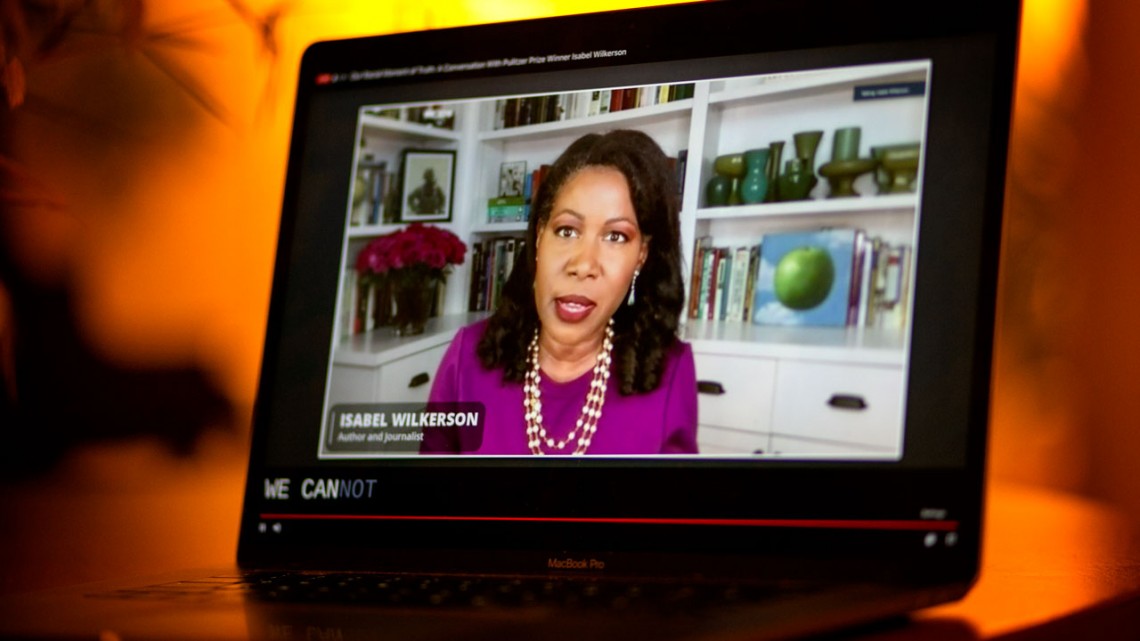
Journalist and author Isabel Wilkerson delivers the Cornell Center for Social Sciences’ annual Distinguished Lecture in the Social Sciences, “Our Racial Moment of Truth,” to an audience of more than 3,500 on Oct. 21.
Wilkerson: US must reckon with ‘long shadow’ of caste system
By James Dean
America is like an old house built on beautiful but unstable land, journalist and author Isabel Wilkerson said to open the Cornell Center for Social Sciences’ (CCSS) annual Distinguished Lecture in the Social Sciences, Oct. 21.
We didn’t build the home but are responsible for its upkeep, she said, and avoid inspecting a flooded basement, bowed walls or cracked foundation at our own peril.
“Like other old houses, America has an unseen skeleton, a caste system that is as central to its operation as are the studs and joists that we cannot see in the physical buildings we call home,” Wilkerson said, reading from her New York Times bestselling new book, “Caste: The Origins of Our Discontents.”
“Caste is the infrastructure of our divisions,” she said. “It is the architecture of human hierarchy, the subconscious code of instructions for maintaining, in our case, a 400-year-old social order. Looking at caste is like holding the country’s X-ray up to the light.”
A proper reading of the X-ray is critical, Wilkerson said, at a time roiled by protests over police killings of Black Americans and other controversial incidents captured on video, such as a white person’s false report of threats by a Black birdwatcher in Central Park.
In her virtual lecture titled “Our Racial Moment of Truth,” presented in partnership with the Migrations Global Grand Challenge and co-sponsored by the Office of Faculty Development and Diversity, Wilkerson told the audience of more than 3,500 that it’s time to reckon with the “long shadow of the caste system” that long ago defined Blacks as the subordinate group in this country.
“Our era calls for us to look deeper than what we think we can see, to awaken, finally, to the infrastructure that is holding all of us back,” she said.
CCSS co-director Sahara Byrne, professor of communication in the College of Agriculture and Life Sciences, introduced Wilkerson, the winner of a Pulitzer Prize in journalism in 1994 and of the National Book Critics Circle Award in 2010 for her first book, “The Warmth of Other Suns: The Epic Story of American’s Great Migration.” Co-director Peter Enns, associate professor of government in the College of Arts and Sciences, moderated questions.
The concept of caste – which Wilkerson called “the artificial, arbitrary, graded ranking of human value in a society” – sounds foreign to many Americans, she said. During a 1959 visit to India, Martin Luther King Jr. was surprised and initially irritated when a school principal introduced him as a “fellow Untouchable,” or Dalit. But as King came to appreciate, Wilkerson said, the idea and language of caste offer a useful way to understand structural divisions in the United States.
The structure was created in colonial Virginia in the early 17th century, when race was still a relatively new social construct, Wilkerson said. Castes could be established by a variety of metrics, she said, but in America “the determining factor early on was what a person looked like.”
If that history seems distant, she said, consider how long slavery endured: Only in 2022 will the United States have existed as an independent nation for as long as slavery existed on its soil. That accounting doesn’t factor in a century of legalized Jim Crow segregation that lasted until federal civil rights legislation finally permitted Blacks as a group to enter the American mainstream in the 1960s.
Consequences of the original caste system are visible today, Wilkerson said: in the videotaped incidents of policing by law enforcement and others seeking to enforce the old social order; in the coronavirus pandemic’s disproportionate toll on communities of color historically relegated to service jobs now deemed “essential”; in the 10-to-1 wealth gap between whites and Blacks, built in part through discriminatory lending practices that denied many Blacks access to government-backed mortgages; and in stereotypes and unconscious bias about who belongs in certain jobs or neighborhoods.
“The idea that people feel the need to assert and control and maintain these ancient hierarchies – we are still living with this today,” she said.
Reading again from “Caste,” Wilkerson described a famous 1936 image of a German shipyard worker who refused to participate in a salute to Hitler – the only member of a large crowd now perceived as being on the right side of history.
“We would like to believe that we would have taken the more difficult path of standing up against injustice in the defense of the outcaste,” she read. “What would it take to be him now?”
A shared and complete understanding of our history would help, Wilkerson said in response to questions. She likened Americans to someone who starts a movie halfway through and can only understand it after seeing the part they missed – in this context, the race-based caste system at the nation’s origins.
“We need desperately to get on the same page,” she said, “and to get to know our country’s history and how we got to where we are.”
Enns thanked Wilkerson for giving the audience the metaphorical first half of the movie – the “home inspection” exposing structural flaws that demand our attention.
“It is our job to take that history, take that building inspection,” he said, “and then work to make a difference with this information.”
Media Contact
Get Cornell news delivered right to your inbox.
Subscribe
